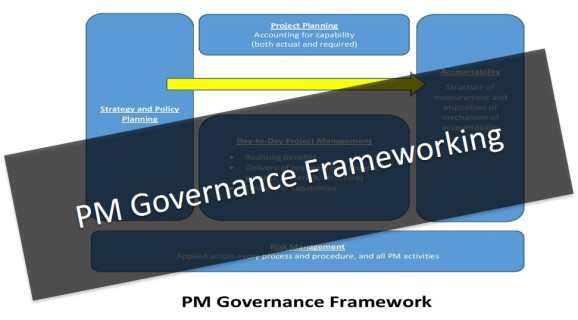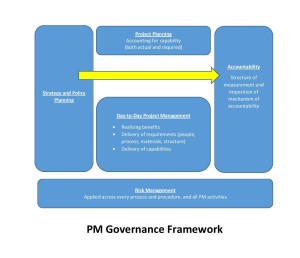
In my last article, discussed four massive Australian IT project failures and why those projects failed. Many projects in the business world today are IT focussed, though the problems facing these are generally the same as those facing other projects. At the heart of these problems is poor project management governance, and central successful governance is having in place a suitable and workable framework.
What is project governance?
When thinking about any governance, we come to the conclusion that it is, in fact, the framework under which something operates. When thinking about everyday laws for example, we could describe them as the framework under which society lives. Examining more deeply, we would find that this framework dictates how those laws have been conceived, how they are put into practice, and how they are policed. We would also consider that the framework then goes beyond this point and requires us to continually learn and evolve from actual experiences.
Project management governance works in the same way. A framework for PM governance will:
- Consider what projects are needed and prioritise accordingly
- Identify leading roles that will ‘control’ the project
- Apply due process and good project management practice throughout
- Ensure delivery of project expectations
- Provide for a review and learning process
Clearly, the main elements in PM governance are:
- Evaluation of the current state and the future state
- Direction, using plans, strategies, and policies to ensure project delivery meets objectives
- Monitoring and control of all project facets throughout the project lifetime
Next time I’ll look at these elements in a little more detail. Right now, I want to outline the six principles for good PM governance.
Putting in a structure for PM governance
When designing a framework for PM governance, there are certain principles that it must embody. Of the two most prominent PM management systems, the Project Management Body of Knowledge (PMBOK) provides a framework while PRINCE2 provides methodology. As such, PMBOK discusses in detail the following six principles of good governance:
- Responsibility: identify lines of responsibility and those who will be responsible
- Strategy: PM strategy coming into line with business/project objectives
- Acquisition: Acquisition of materials and expertise using tools such as cost benefit analysis
- Performance: ensuring outcomes meets objectives
- Conformance: compliance with rules, regulations, guidelines, standards, policies, and procedures
- HR: development of the team and individuals
PMBOK, PRINCE 2, and standard AS/NZ 8016:2013 all insist on an organisation putting in place a PM governing body, which will be responsible for the success of the project. Ultimate responsibility lies with this PM governing body, though tasks may be delegated. Diagrammatically, this framework looks like this (click to enlarge):
So how do you design your PM governance framework? You start with the three PM governance elements that we highlighted earlier: evaluation, direction, and monitoring and control. And that’s what we’ll be looking at in more detail next time.


Trackbacks/Pings